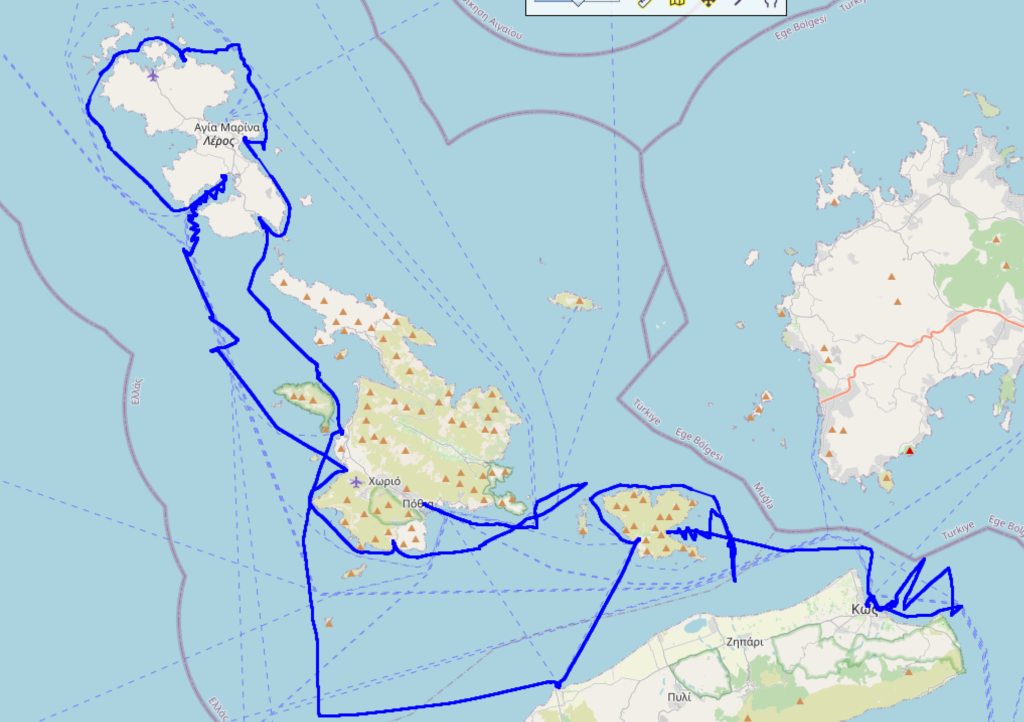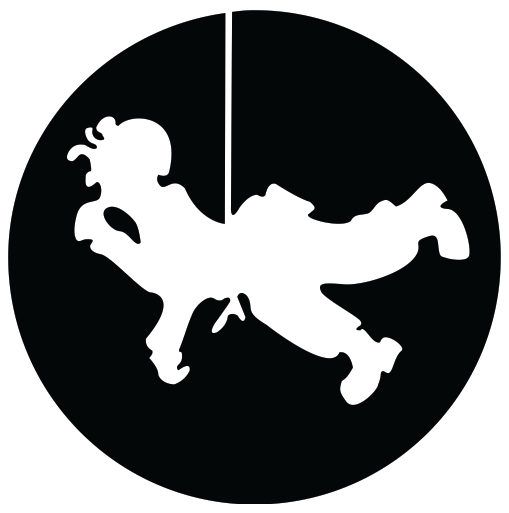For the past few years, Phil Sargent has been spending his summers sailing his Yatch Elin around Greece. He has a pretty generous offer of letting people sail around on his boat with him so long as they pay for food. After doing a competent crew course the year prior I asked if James and I could join him for a trip, which he was more than happy for us to do.
On Saturday the 7th of June 2024 James and I met Phil and Sarah on his yacht and spent the night in the south Kalymnos harbor. Sarah was from New Zealand and joined us for the week to build up some sailing experience.
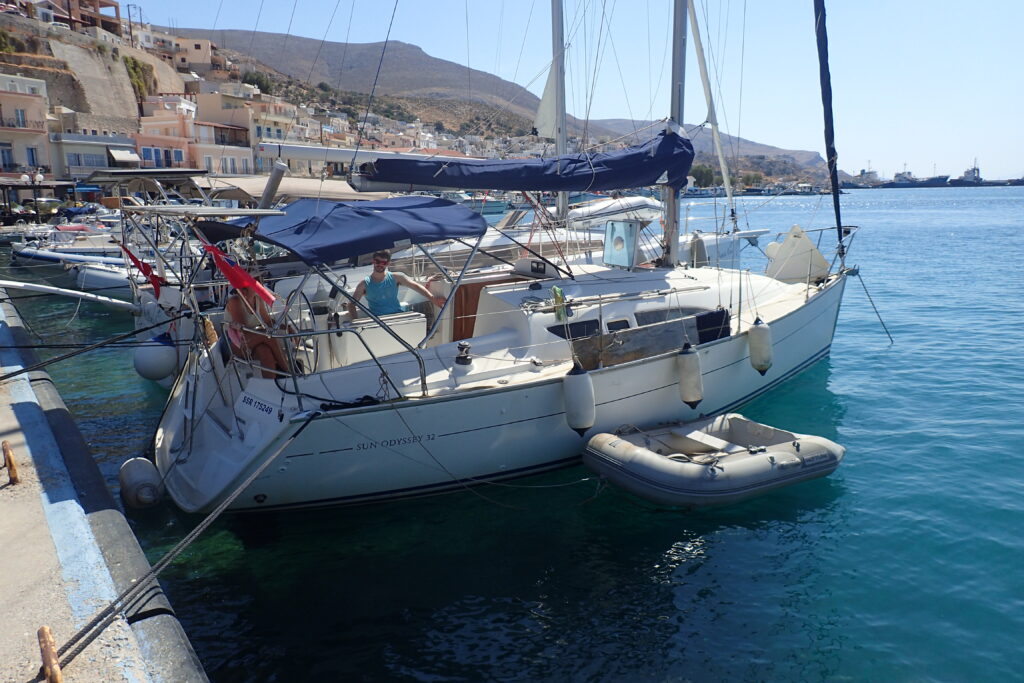
Our original plan was to stock up on supplies while waiting for the wind to die down then head out on a big trip around Kalymnos and Leros. But being a Sunday in Greece, none of the supermarkets were open. So instead we decided to get a bit of sailing in and head around to a bay on the southwest of the island before heading back to the same harbour in Kalymnos. On the way out the wind looked calm, we brought the sail up to reef 2 (about 2/3rds max surface area) and came away from the protection of Kalymnos where the wind was gusting at up to 27 knots.
With Phil’s boat being relatively small (5 tons, 9.6 m/32 ft long) and quite high in the water (1.5 m draft) it doesn’t do too well in such windy/wavey conditions. Steerage became difficult as the boat was being knocked about by the waves and the sail was too overpowered to easily control speed.
Phil started faffing with the reefing lines to give the mainsail a more reasonable surface area, meanwhile, Sarah was struggling to make the boat turn in the right direction and we were on course to collide with some oncoming sailboats. With the rudder hard over and the boat not turning in the direction we wanted the safest option was to release the mainsheet and loosen the jib while turning the boat into the wind. This effectively stopped the boat giving the other boat with better steerage an opportunity to get out of the way.
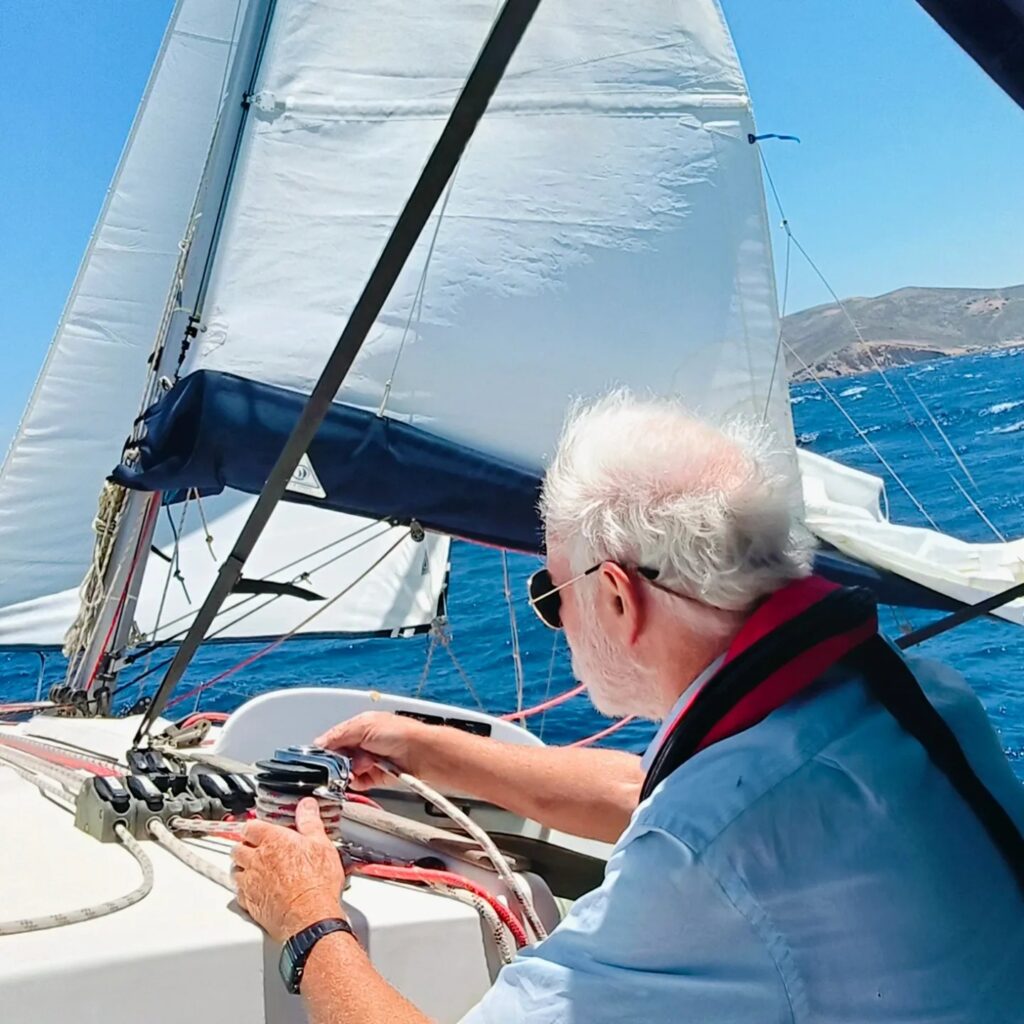
After Phil got the reefs in Sarah regained more control of the boat, we decided to turn back. Our new plan was to head back around to the other side of Kalymnos where hopefully the wind was a bit better. Now on a broad reach, we quickly made progress back to Kalymnos and entered a busy bay where all the mooring boys were already taken.
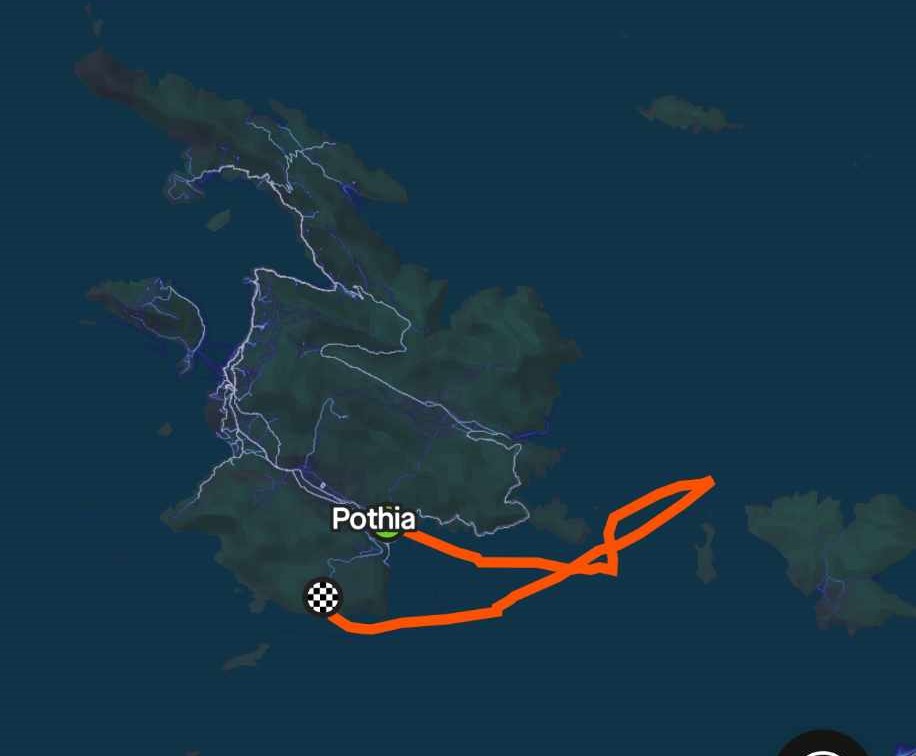
Our initial attempt at anchoring involved going in front of two other boats. I asked Phil if I should get the fenders out just in case, to which he replied that it was unnecessary. The anchoring attempt failed as the anchor hit a soft mud bank, like anchoring into butter we slid backwards. As we drifted backwards, Phil had to run back to the helm to avoid us crashing into another boat, avoiding them by about a meter or two while the people on the other boats crew shouted: “Fender!, Fender!”
Our next attempt involved sailing closer to the other boats but into a shallower area so we could lay a shorter chain giving us a smaller drift radius. At a depth of about 5 meters, we dropped the chain and started to drift backwards. This time the anchor hit a nice sandy patch at about 7-8m and the boat slowed down as the chain tension increased. We then let out another 25-30m of chain to help dampen the force on the anchor and give it a bit more weight. Both in combination would hold the boat within about 20m of the position of our anchor. To avoid hitting the other boat we tried laying a side/stern anchor, but the side anchor didn’t take as the ground was too hard.
Deciding it probably didn’t matter we spent the rest of the evening swimming and lazing around before dinner/bed.boat
Later in the night I was woken up by the boat swaying violently from side to side, I went up to check we were still in the spot we anchored and found Phil reassuringly already on the deck.
It turned out that the wind had stopped causing the boat to settle in the troughs of some waves caused by all the wind earlier in the day so wasn’t really anything to worry about. The biggest concern was the possibility that we could drift into the boat next to us as there wasn’t much of a wind to keep both boats pointing in the same direction, but this didn’t happen.
Day 2 – 10th of June
In the morning there wasn’t any wind but the strong wind from the previous day meant the swell was quite high. So we planned to motor out of the bay and head away from Kalymnos until the wind picked up. Phil’s auto-helm system was pretty good, despite not having a built-in GPS it quite reliably got us heading in the right direction although apparently, it doesn’t account for the boat being blown sideways so that’s something to watch out for.
We attempted to moor up on a dock in Melitachas to stock up on food. But we were stopped by a Greek man who told us the bay was just for ferries and sent us over to another mooring spot round the corner. Many of the mooring spots in Greece are public property and require no mooring fees. However, this also means the mooring situation is a bit like the Wild West in terms of who has priority.
Around 3 pm we anchored in Xirokampos, the bay had lots of mooring buoys marked on Navionics in 2015 but these had been removed apparently. So, we had to anchor up again. We then went for a bit of a swim before lounging around on the boat reading books, then a couple of charismatic French men came over to greet us in their £6,000 inflatable sailing dingy and offered to take Sarah for a ride.
Sarah hopped on board and was taken over to their luxury yacht, presumably for champagne and nice food. James, Phil and I were incredibly jealous not to also have been given an invite probably due to our lack of bikini.
A while later Sarah arrived back and told us they were a group of corporate lawyers from the company that makes Barbie on a “work seminar” on the luxury company yacht. Their yacht had 6 double rooms, a kitchen, a chef, a large seating area, jet skis, water skis and a hydraulic platform to get from the deck down to the water. They did invite us to their “all white” party later, where all attendees must be dressed in white. Sadly none of us had all white clothes with us :'(.
Later Sarah and Phil took the dinghy to shore while James and I swam. Arriving at the rocky shore I slipped and cut my big toe on a barnacle shell on one of the rocks. Although my foot was now bleeding this luckily forced me to look down and I saw lots of purple spiky sea urchins – which we were very careful to avoid.
At the front of the marina, there was a nice shoreside restaurant called Aloi serving traditional Greek food, the wine and beer were pretty cheap (6 Euro per 0.5L) I think we ordered a bit too much as I was feeling a bit giddy.
By the time we had finished it was dark with a crescent moon there wasn’t much ambient light, luckily we left the anchor light on and could just about see out boat in the distance. James and I stood up from the table undressed down to our underpants/swim gear, passed our stuff back to Sarah and Phil who were headed back in the paddle boat and swam back in the dark. The water was still warm and it was a fairly pleasant swim.
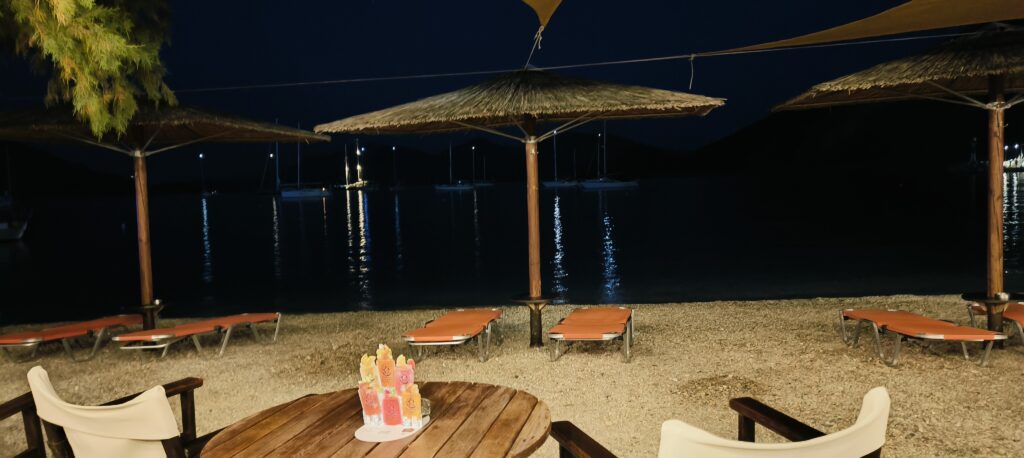
When we got back the boat the bay was really quiet other than the sound of the French lawyers having a party on their boat, cheering at someone climbing their mast. Once they had noticed we were back, they started heckling Sarah to go over to join them.
I suggested I could crash their party by climbing their Anchor chain. Phil said that was impossible to do but seeing this as a challenge I got into the dark water swam around the boat to climb the chain. You couldn’t quite go up hand over hand up the chain as it was quite wet and slippery but i could hold onto it enough to get a hand on the deck, swing my foot over and clamber my way back onto the boat.
Now back on the boat I could see 2 of the French getting into a tender and heading towards us to get Sarah, having proven the concept on Phil’s small boat I thought why not have a go at infiltrating the big French luxury yacht party. If the guy being winched up the chain was getting cheered at surely getting onto their boat without using the hydraulic platform was more impressive.
I put on my head torch ready to turn it on and shout if any boats started coming towards me in the dark but kept it off so the French didn’t see me coming while I sneakily swam over to the front of their yacht.
I arrived at the same time their tender was coming back in, it looked like Sarah hadn’t accepted their invite. I waited holding onto the chain in the water until they were back up on the deck.
The French boat was much higher out of the water than Phil’s boat so it was quite a climb to the top of the chain but luckily bigger boats have bigger chains meaning I could get purchase on the chain with my feet, this crucial difference meant it was possible to make progress up the chain until I could get a hand on their deck and pulled myself up.
I then made my way over to the big party area at the back of the boat. Expecting them to be impressed by my antics I was instead greeted by silence and shock, they had no idea how or why a soaking wet English man was on their boat just in his underpants, especially as access to the boat was only possible by the hydraulic lift at the back of the boat.
I now had to explain myself as I realised they didn’t really know who I was as they had spent so much of the day focused on Sarah.
Not impressed, one of the French men said: ‘what were you thinking? It is very dangerous to climb the chain…’ I said I thought it wasn’t that unsafe but it looked like I had over stayed my welcome and I wanted to be anywhere else.
Not wanting to jump off the boat wearing my non-waterproof £12 decathlon light. I asked if I could be lowered off the boat. They said yes and I stood on the platform while it slowly lowered me to the water while they stared at me.
I swam back to our boat and was greeted with a much warmer welcome before going to bed.
Day 3
The night was hot, I didn’t need a sleeping bag and just slept on top of it although the bay was also full of mosquitos that came in to eat me overnight. I probably should have used Phil’s mosquito net.
I wasn’t expecting it but the Greek islands around Kos and Kalymnos have excellent 5G internet coverage everywhere. I think this was probably because they have phone masts on the top of most of the islands and not much in the way of them.
We stopped off at a harbour in Panteli for lunch, afterwards James and I practised tying a round turn and two half hitches. A local fisherman came over to us to tell us we were doing it all wrong and showed us how to tie a bowline. I tried explaining the round turn and two half hitches was a good knot as could be untied while under tension the fisherman just looked at us confused and showed us how to tie a bowline again.
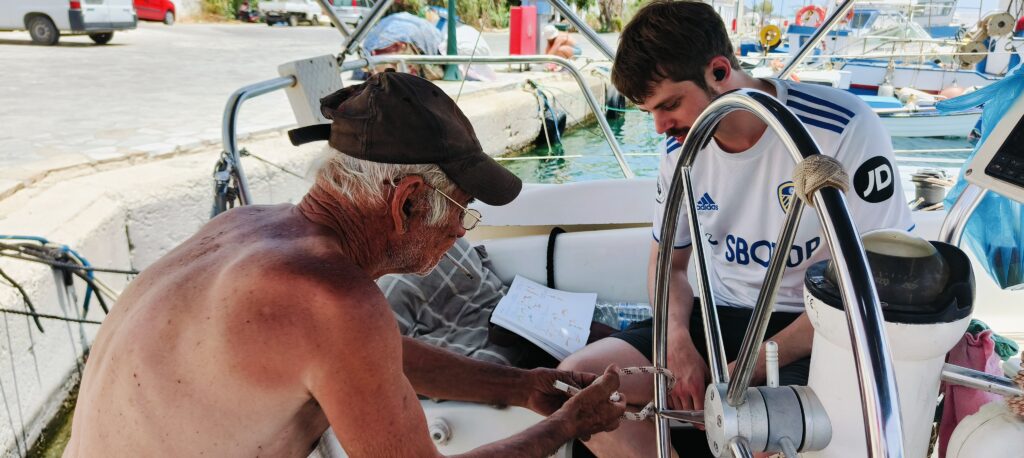
I’d installed Navionics on my phone, you can get the 14-day free trial just before you go out, I also had an app called Windy installed, this was broadly reliable in predicting the weather but didn’t account for the effect of wind dead zones at the base of cliffs or wind shielding from Islands. Phil also had an app that sets off an alarm if you’ve strayed too far from the place you’ve anchored just using phone GPS.
Once back on the boat headed to the northeast side of Leros, we stopped and had a look around the island, there were lots of WW2 remnants, bunkers and trenches. Some nice coastal features too.
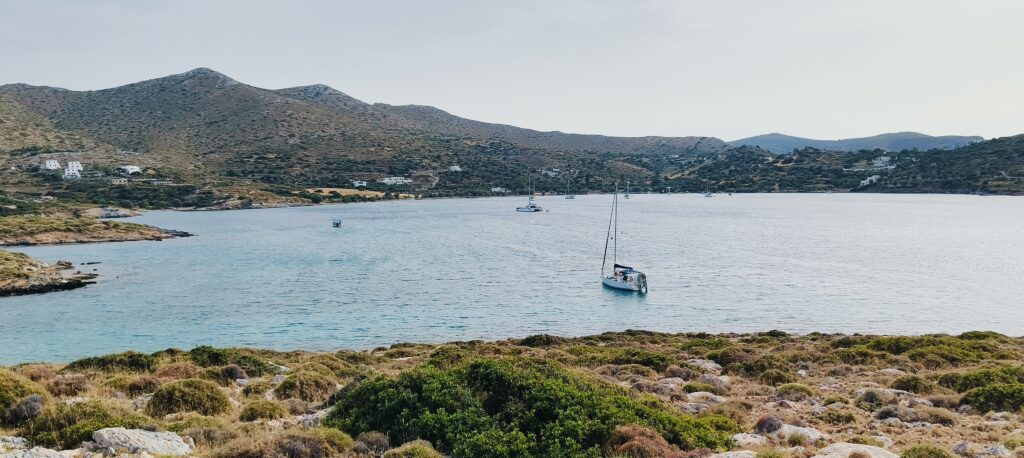
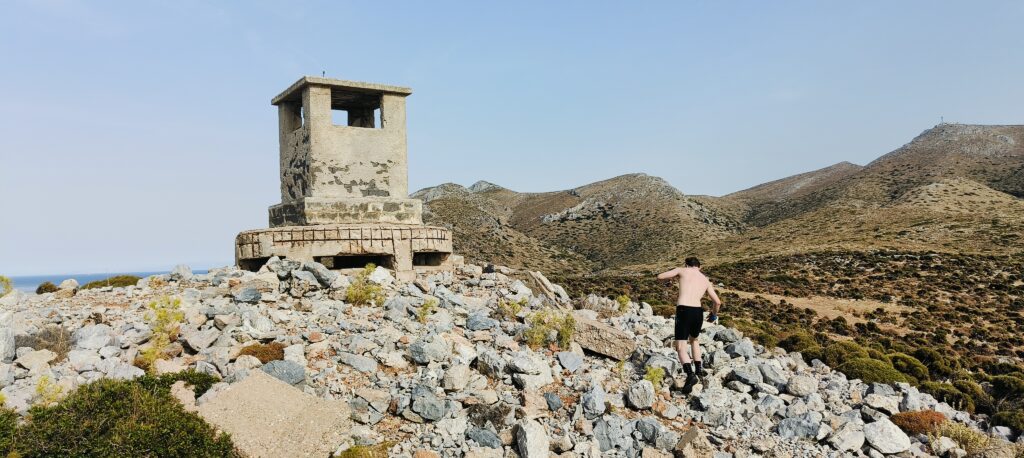
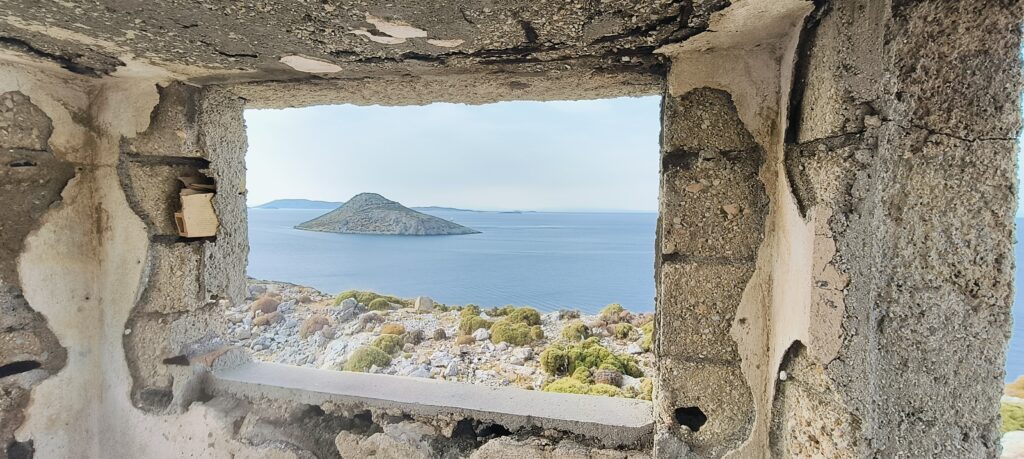
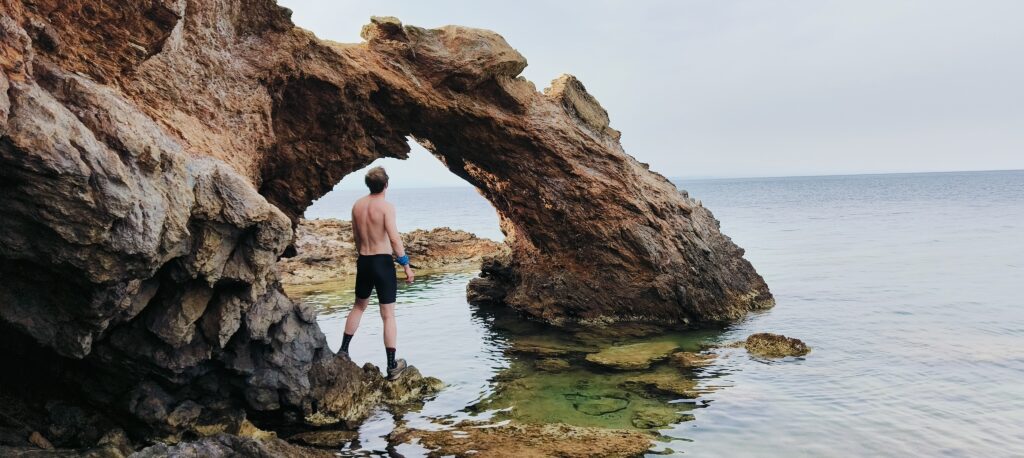
Day 4
It had been quite a challenging night’s sleep with James, for some reason, I was moving around a lot. At one point I dreamt that I moved my hand as I was gesturing and suddenly, I was woken up, it turned out I put my hand on his face and freaked him out. Then I touched his leg a bit later on with my knee and he jolted me awake again, from that point onward I just zipped myself up in my sleeping bag in the 26°C heat to stop me from accidentally touching him in my sleep.
The wind was so calm overnight the water in the bay looked like glass, you could clearly see the patches of sand and seaweed 8 meters below the boat. The anchor had embedded itself nicely in a patch of sand, it’s best to avoid the seaweed as anchors typically don’t take well to them and the seaweed might just be living on a bed of rock. In this bay rocks only appeared under water around 30-40m off the shoreline. Anything beyond that was sand or weeds.
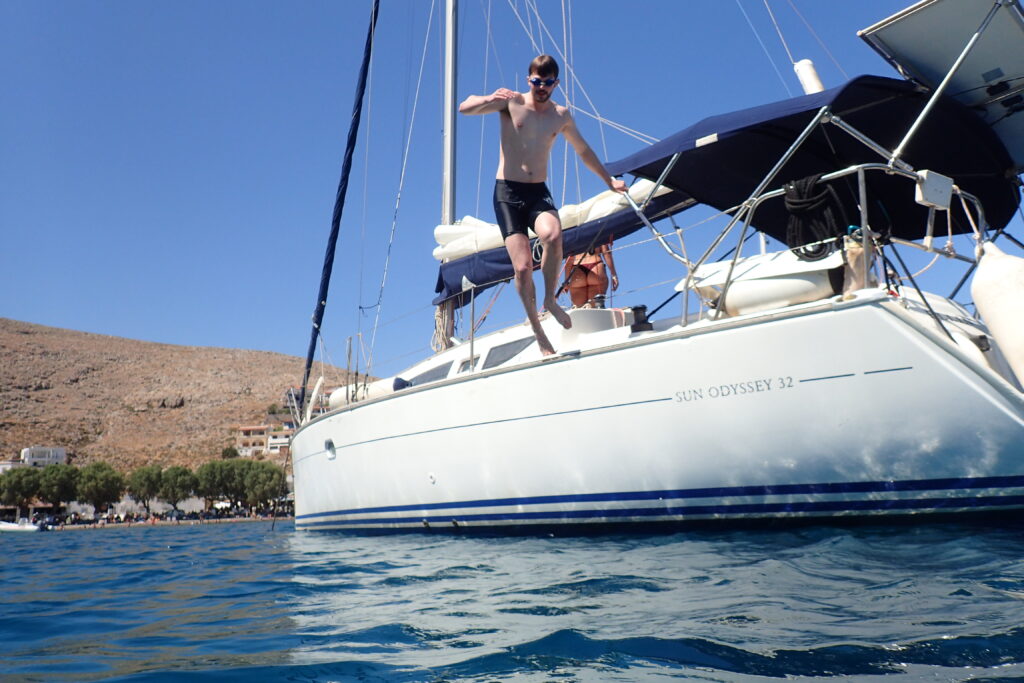
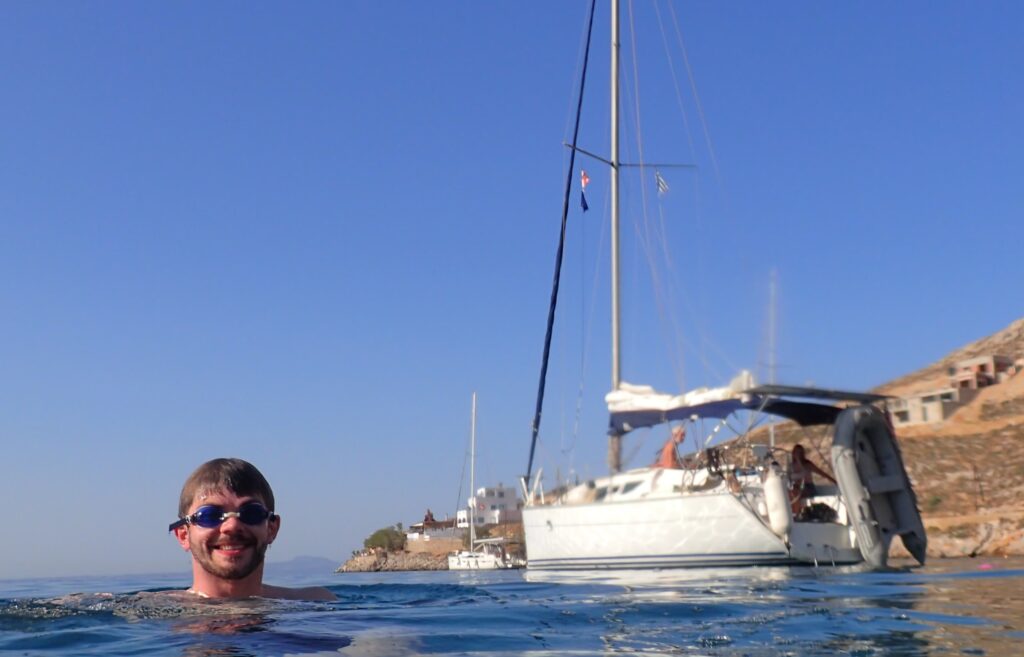
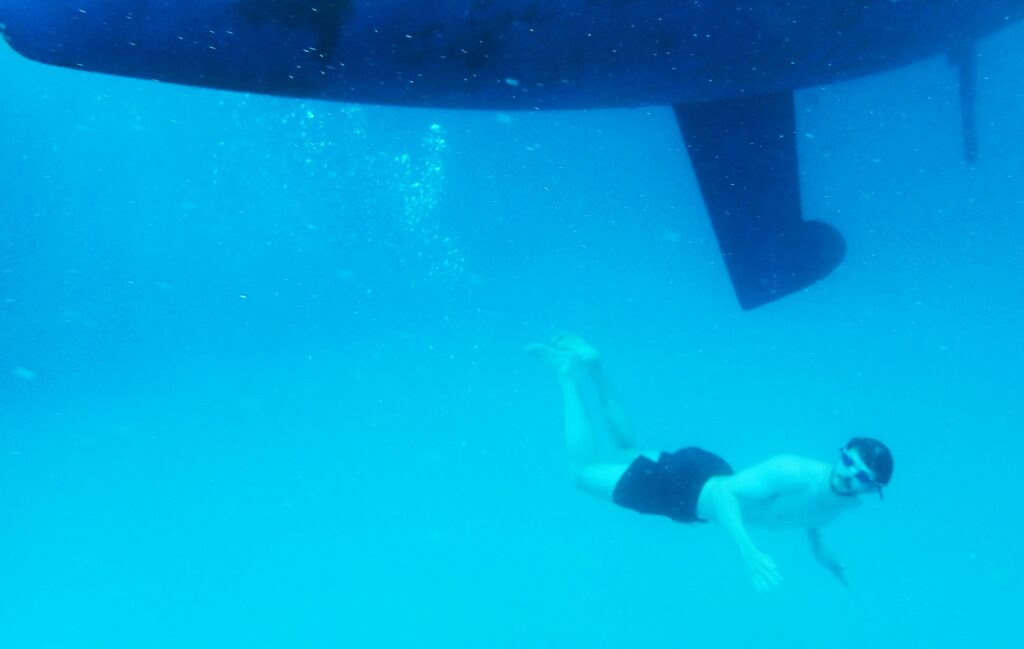
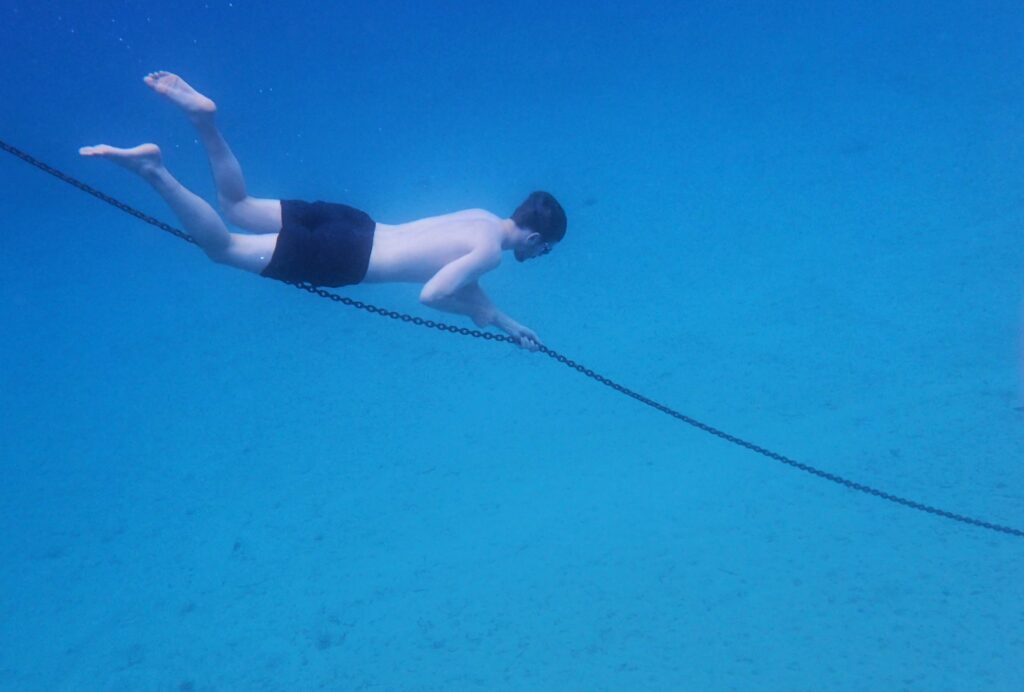
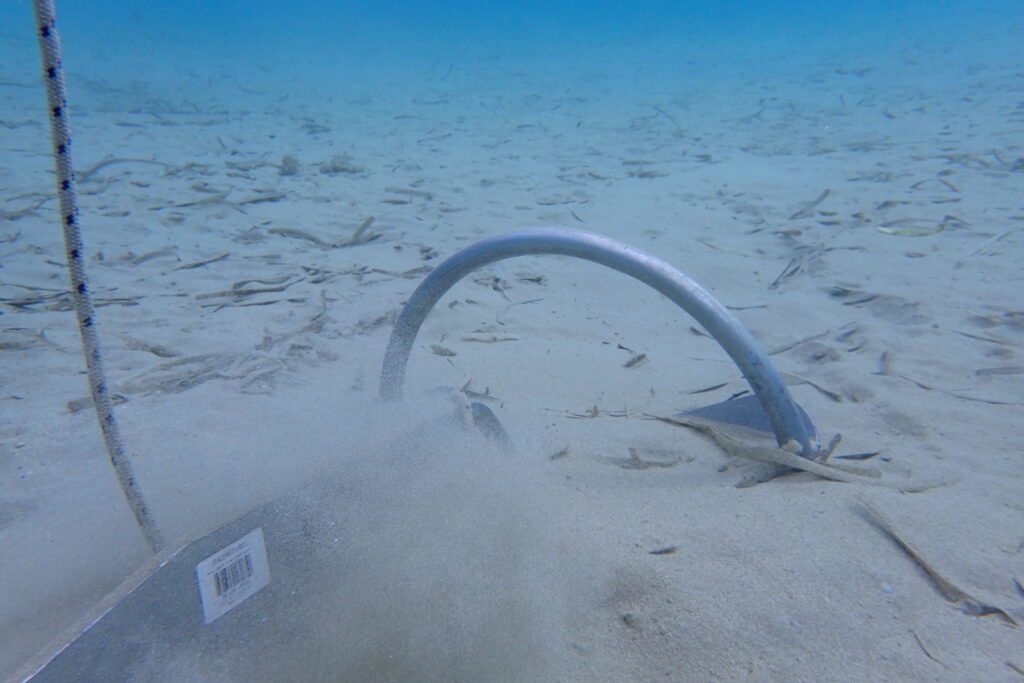
Phil let me have a go at lifting and lowering the anchor. I struggled to see the boat going backwards in reverse as the manoeuvre was so slow, apparently if that’s the case it’s best to watch the boat move around the bubbles in the water.
When finding a suitable anchoring location, you’re supposed to point the boat into the wind and let out the chain until the person controlling the anchor sees it hit the sea bed or when the amount of chain let out matches the depth gauge, you then move slowly backwards (about 0.5 knots) while letting out the chain until you have around 3-4x the length of chain going sideways compared to the depth of the anchor. More chain = more secure holding but larger range of movement so best to weigh this up depending on the situation. You can also run a line ashore if you want to restrict the swinging radius of your boat.
We motored out of the bay and did a little bit of sailing off the jib with what little wind we had. We saw some dolphins jumping around near some fish farms. Presumably to eat some stray fish.
We then motored into Leros marina, which was quite busy. We attempted to go astern next to some other boats in the key with an anchor holding us out and two lines to hold us back. With all the other spots other than a narrow space just big enough for us between two boats free.
On the way in we went aground with our keel, as soon as Phil realised he put the boat hard into reverse so we slowly slid backwards off the rocks. We had a look at the keel afterwards, it’s a big solid piece of steel so it just the paint that was damaged. Although at higher speeds Phil said it can induce stress fractures where the keel is attached to the boat. Had we run aground going faster we may have needed another boat to pull us off.
To make things extra difficult for us the wind picked up to 15 knots as we were approaching our birthing spot. An angry French man then came out of his boat to shout at us (“The space is too small!”), Phil said it was fine and the French guy probably just didn’t want us to risk scratching his shiny boat.
After a failed anchor grab we’d have to reattempt but decided it wasn’t worth it and rang the nearby marina to ask if they could find us a spot to moor up.
Phil called out the marina’s name 3 times followed by the name of his boat on channel 11 (indicated on a nearby buoy and in the latest seafarers guide) then when the marine manager answered they gave us instructions to birth.
The first place the marina manager told us to go was too narrow and we forgot to put any fenders on the back of our boat so we made a little contact with the back of one of the other boat. (Always put fenders on the back of your boat when going astern) and maybe don’t listen to the marina managers.
It might have fit if the front tension lines on the other boats weren’t so tight. I think just f
for shopping trips it’s probably easier for the skipper just to anchor and use the tender to get onshore rather than attempting to moor up if it looks difficult. Or to touch and go on a mooring spot.
Leros was home to a massive refugee detention centre and a military base. But also, some nice kebab shops where you could buy a tasty kabab for 3 euros.
On the way out the wind was still a tasty 12 knots perfect for Ellin. Once clear of any obstacles we sailed out of the bay. Then once out of the bay, our destination was directly upwind and as the wind died off tacking upwind to make progress was futile.
After a while we gave up and went under engine instead, Phil suggested we do some night sailing. GPS makes this much easier and we did all the stuff we did during the comp crew course minus the paper nav.
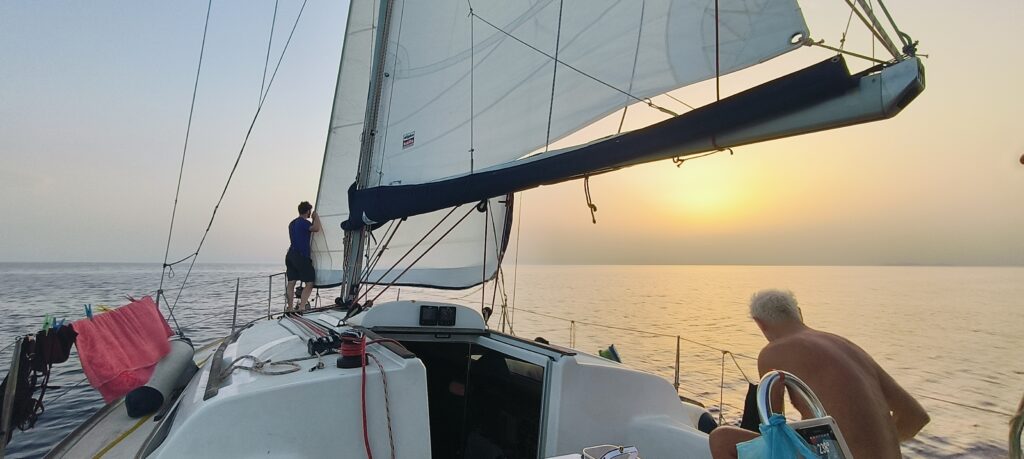
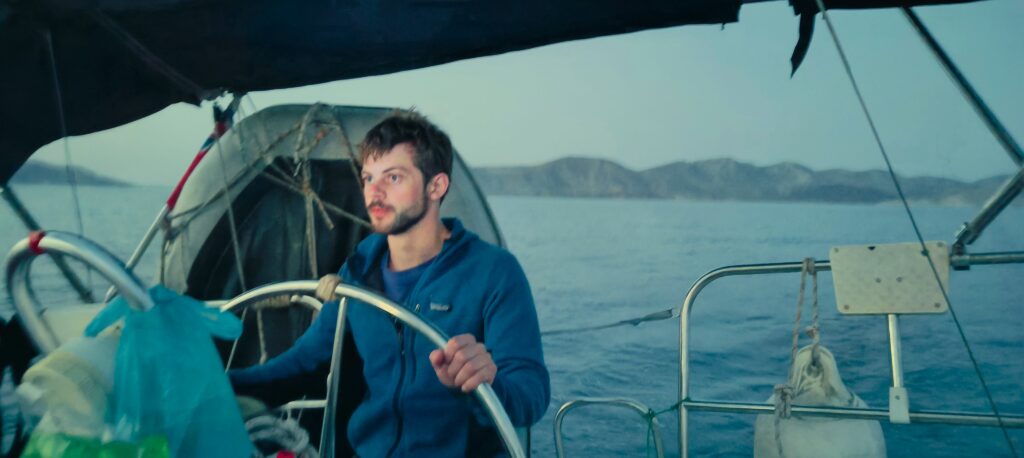
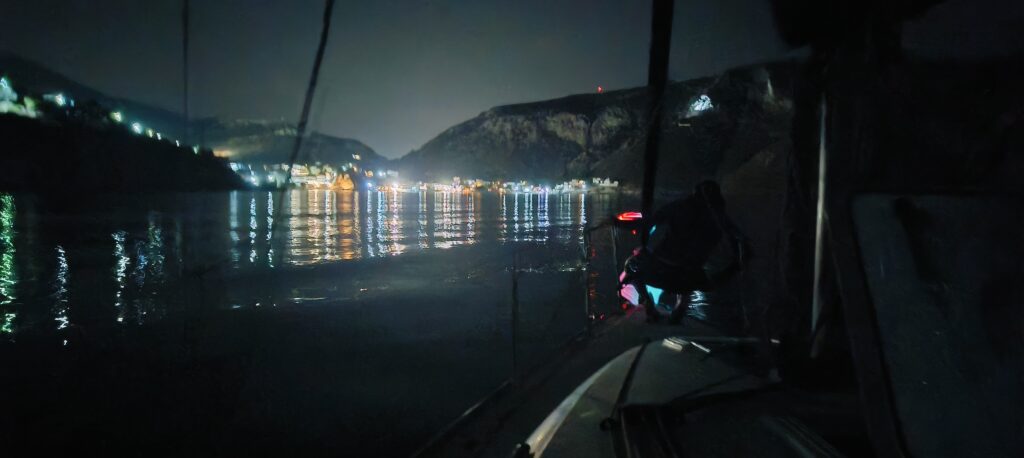
When we arrived there was nobody else at the beach, although it became clear later why this was. The beach was full of night clubs playing loud music and due to the unprotected nature of the beach, the boat moved quite a lot with the waves. Probably best to anchor in more protected bays wherever possible.
When dropping a chain at night it’s much harder to see the colour of the ground and avoid dark patches. Anchoring could take a few attempts, if an attempt fails and the anchor is really stuck then it might be too difficult/dangerous to retrieve it. In which case if you tie a line and a fender to the end of the chain, take the co-ordinates and use this as a buoy, you can use this to later retrieve the boye when conditions improve. Much easier to pull up the anchor from on deck than below.
To stop the chain pulling on the winch overnight one thing you can do is wrap a prussic around the chain, then with a stainless-steel connector join this to a dynamic rope using the two cleats to hold the dynamic rope in place.
Day 5
In the morning the water was very calm so I went out to grab some photos
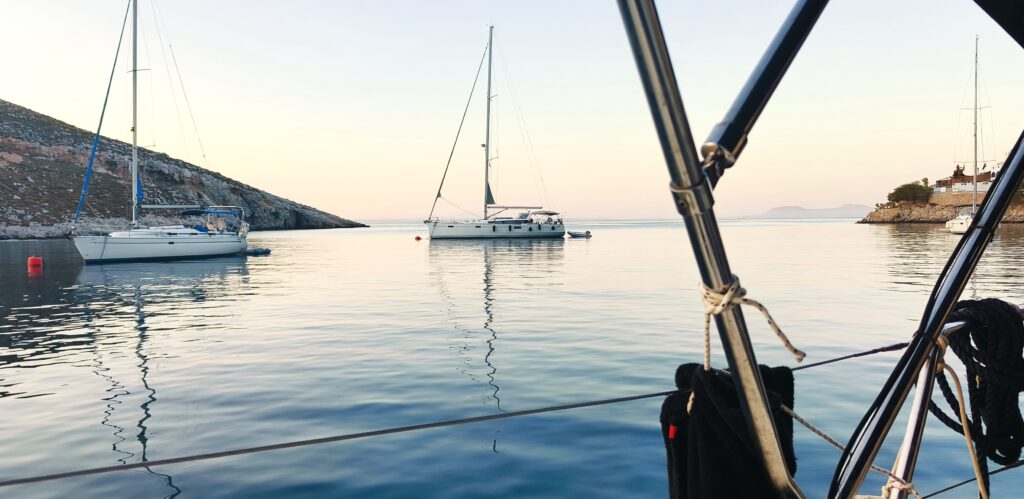
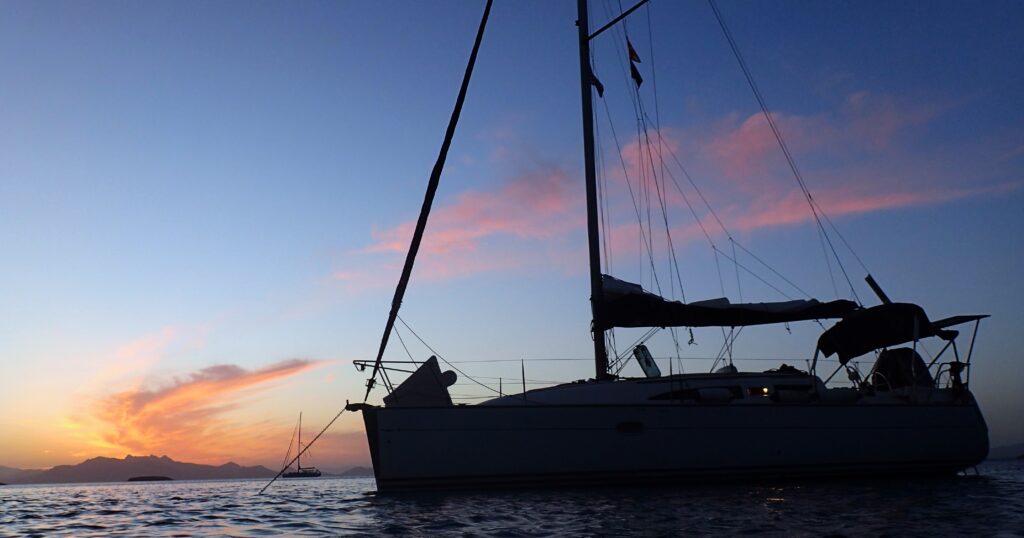
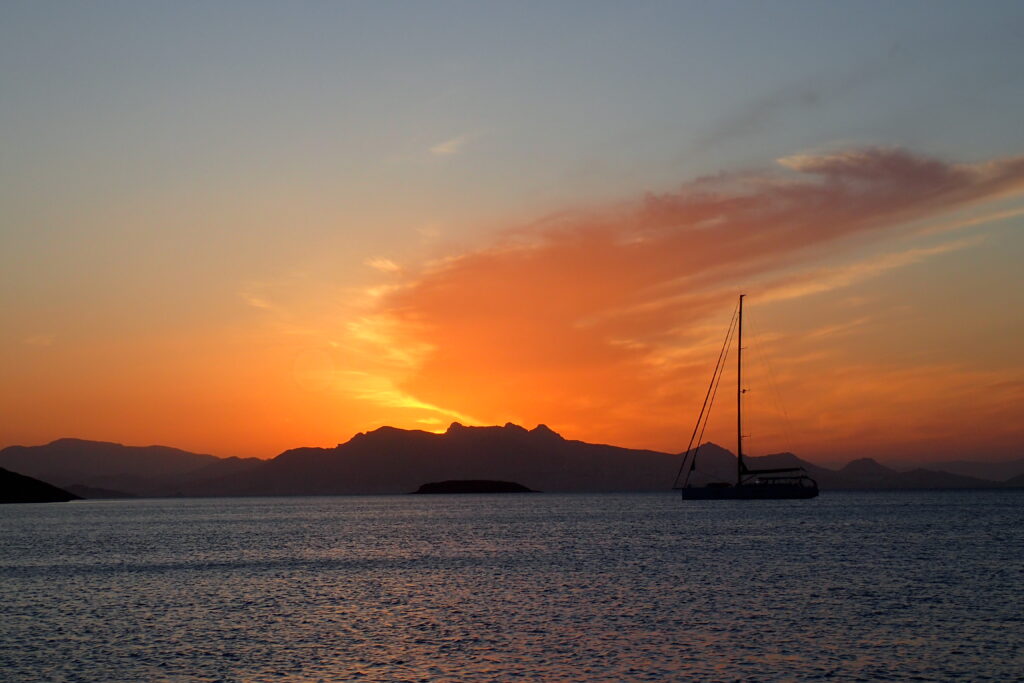
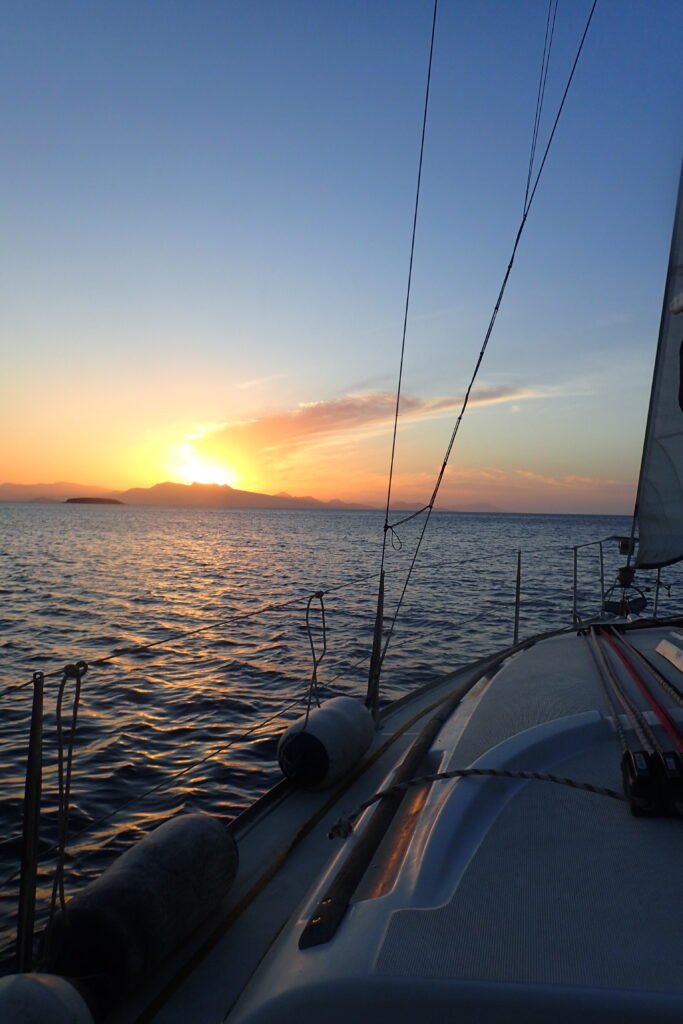
Phil said that for chartering boats it’s always best to book in January for the best rates as companies try to fill their schedules early year. It’s worth looking at a copy of the Greek Waters Pilot by Rod Heinkel, another interesting idea was that boats can go back-to-back with anchors in a bay if space allows to form a star-shaped raft. He also pointed out on the journey that in the med the wave’s height is proportional to the length of water waves blow over.
We woke up for an early start the wind was on average 15 knots but gusting at 20 knots so to avoid losing control of the boat or any hassle with the mainsail we just sailed on the jib which was enough to give us 4-5 knots of speed through the water.
Sailing with just the jib in 15 knot wind is not enough to give us steerage through a turn as the boat stalls before it can complete the turn. Two options are to go behind the obstacle if it’s safe to do so or turn the engine on to power through the turn.
While the wind was strong enough Phil let us do a man overboard drill with an orange buoy, I remember this being the most difficult part of the sailing course the year prior but after learning how to sail dinghy and getting a better idea of how sail boats work, I found the task much easier. The difference in a yacht is mainly in the more limited moveability, in a dinghy you can quickly swing round and pick up the person on a close haul. In a yacht everything is slower, and the turns are less sharp, so you must go out further and try harder to keep track of where the person is in order to complete the mauver drill and come in at a shallower angel to avoid losing momentum as the boat steers into the no-go zone.

Day 6
On the last day James and I went over to the local water sports centre to see what we could do. Unfortunately, it was too windy for them to let us borrow any of the small catamarans, but they were willing to let us use the windsurfing boards. The instructor told us that wind surfing follows the same principles as sailing but that it requires a lot more balance.
To get started you stand on the board and pull the sail up using a rope near the front of the sail and then hold the sail near the front of the mast with your forward hand. The sail will naturally want to move into the wind just like with normal sailing.
Once you’ve got your balance you can pull in the sail with your backwards hand powering up the sail gaining forward momentum. At this point it is important to get the board moving through the water by moving the sail to the front of the board while keeping a straight back which is rather difficult, without any forwards movement it’s impossible to get and steerage through the water. Steerage is achieved by changing your foot position and putting pressure on the right part of the board.
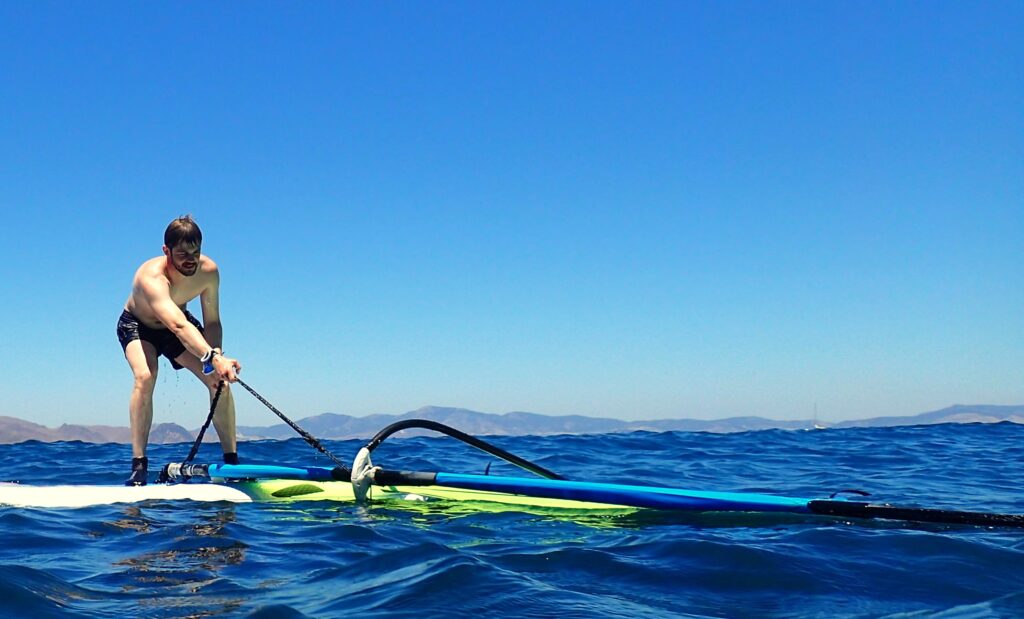
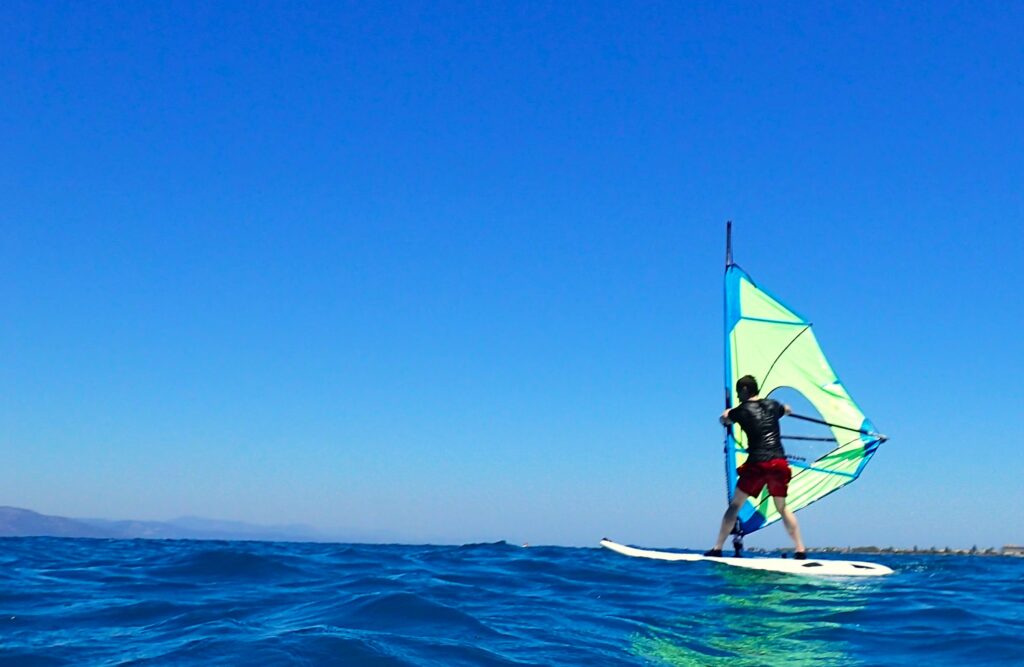
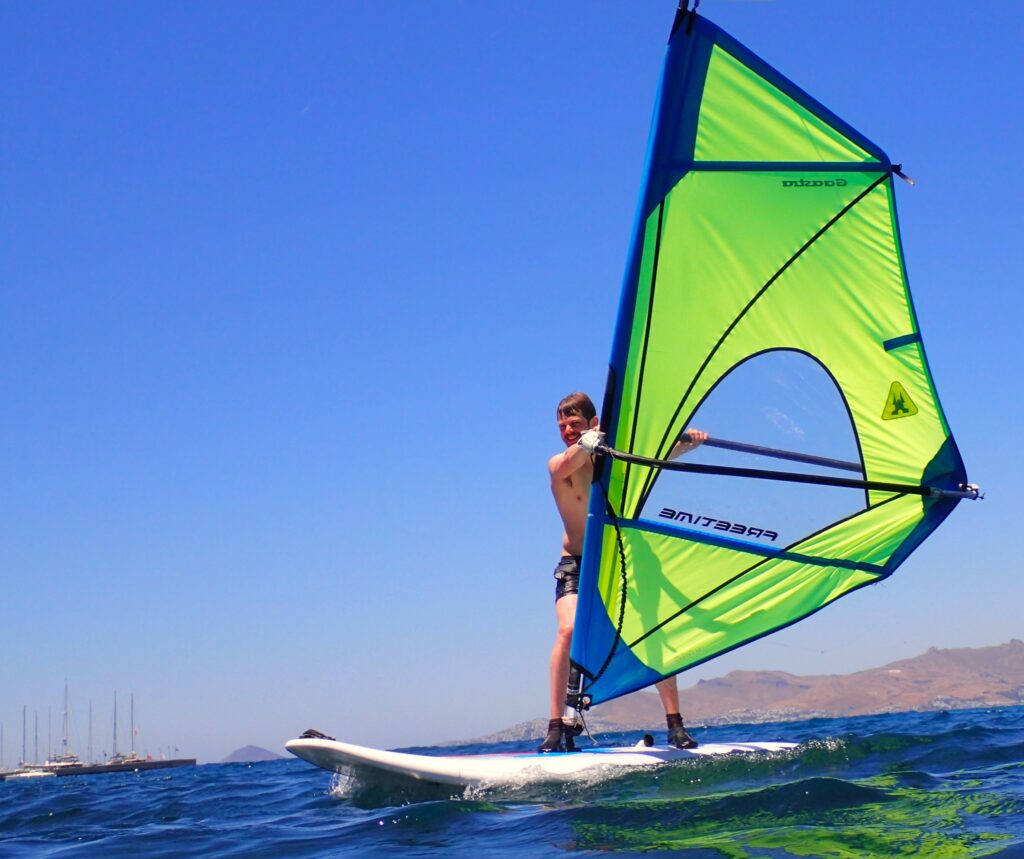
It was quite easy to sail the board across the wind (the sea was relatively flat with a constant but strong prevailing wind). However, making progress up wind requires quite some skill, I was only able to achieve quite a small tacking angle, to turn the board you hold the front of the sail with both hands and move it to the opposite tack. You then use your feet to swing the board round and step around the front of the board completing the tack. If you don’t do this quickly you lose too much speed and end up getting blown down wind which I did repeatedly.
After a while my back started to hurt so I figured I’d call it a day. James looked like he was getting the hang of it, although the day had been mostly swimming for James, but by the end he’d figured out how to sail across the wind too.
After much fun on the water we headed back to the boat to pick up our things before setting off back to the UK.
